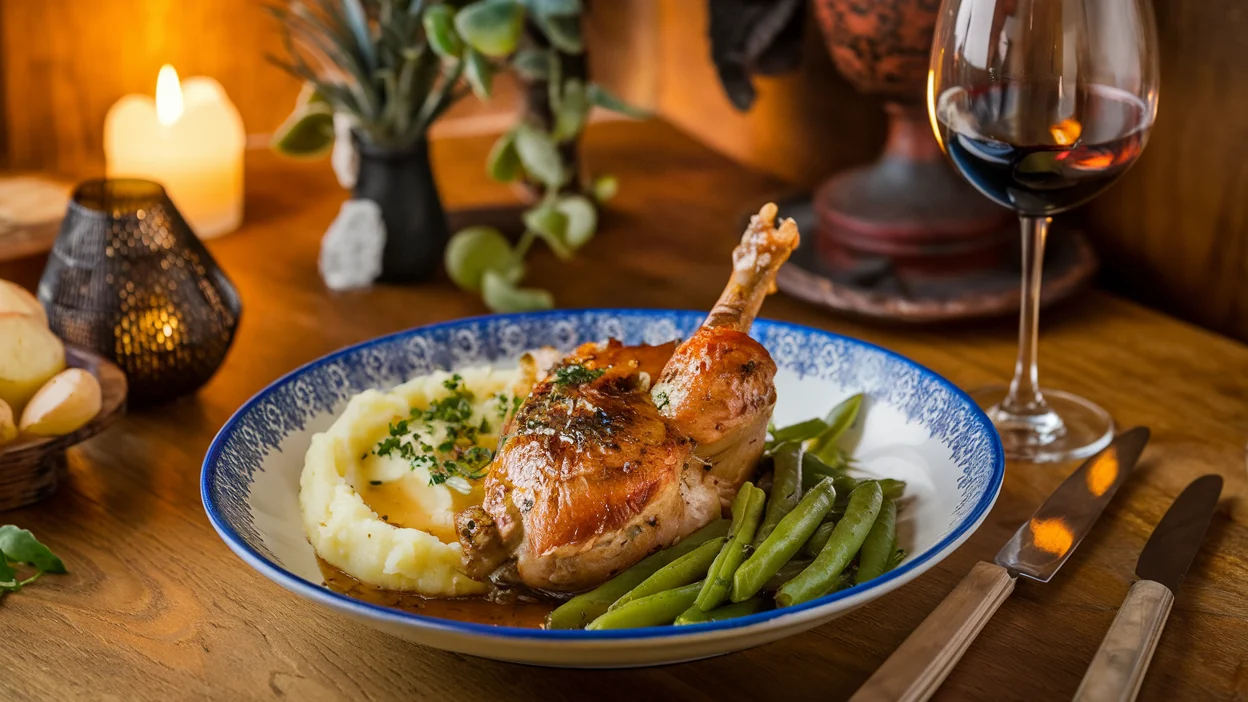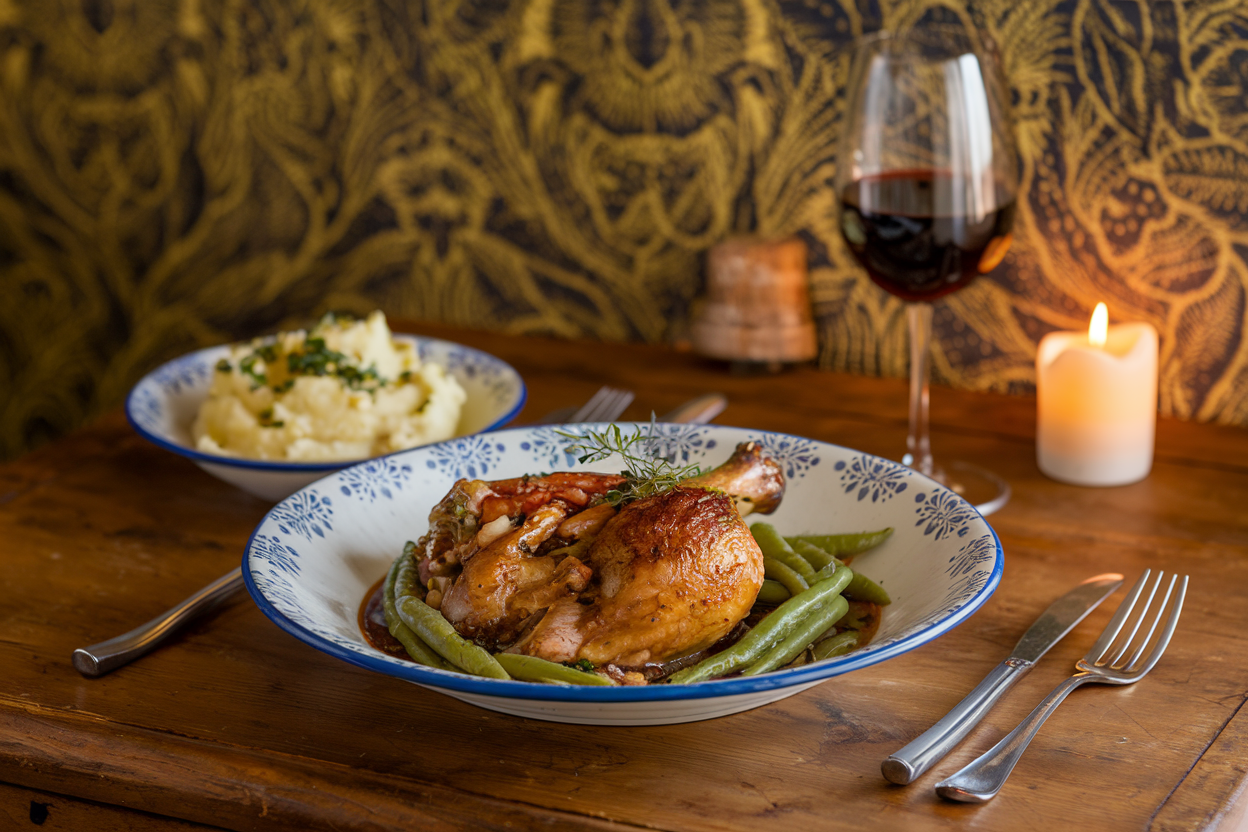Imagine stepping into a kitchen where time slows down and the tantalizing aroma of simmering wine and tender chicken wafts through the air. Coq au Vin, a dish steeped in French culinary tradition, offers more than a hearty meal; it’s an experience that connects you to generations of cooks who perfected its rich, soulful flavors.
In this guide, you’ll learn how to recreate this timeless classic with ease, discover tips for perfecting its flavors, and uncover ways to make it uniquely yours. Whether you’re a seasoned chef or a home cook eager to impress, this Coq au Vin recipe will transport you straight to the heart of France.
Table of Contents
What Is Coq au Vin?
At its core, Coq au Vin is a dish that celebrates simplicity elevated by technique. Literally translating to “rooster in wine,” it originated as a way to tenderize tough cuts of meat by slow-cooking them in wine. Over time, the recipe evolved, incorporating ingredients like bacon, mushrooms, and pearl onions to create a dish that’s as elegant as it is comforting.
This recipe isn’t just about following steps; it’s about savoring the process. The careful browning of chicken, the slow melding of flavors, and the final unveiling of a dish that feels both rustic and refined—it’s an art form you’ll be proud to master.
Essential Ingredients for Coq au Vin
Creating an authentic Coq au Vin starts with choosing the right ingredients. Each element contributes to the depth and harmony of the final dish.
| Ingredient | Quantity | Notes |
| Chicken (bone-in) | 1 whole or 8 pieces | Dark meat, like thighs and legs, is ideal. |
| Red wine | 750 ml | Burgundy or Pinot Noir works best. |
| Bacon lardons | 150 g | Adds smoky richness. |
| Mushrooms | 200 g | Button or cremini for earthy tones. |
| Pearl onions | 200 g | Sweet and tender when cooked. |
| Carrots | 2 | Thick slices hold their texture. |
| Garlic cloves | 3 | Minced for robust flavor. |
| Chicken stock | 1 cup | Enhances the sauce’s depth. |
| Fresh herbs | Thyme sprigs, bay leaf | Essential for authentic French flavor. |
These ingredients may seem straightforward, but the magic lies in how they come together.

Step-by-Step Instructions to Make Coq au Vin
Preparation
Before you dive into cooking, take time to prepare your ingredients. Marinate the chicken overnight in red wine, garlic, and thyme for deeper flavor. If time is short, even a couple of hours can make a difference.
- Gather your tools: A heavy-bottomed Dutch oven or deep skillet is essential for even cooking.
- Prep vegetables: Peel and chop carrots, slice mushrooms, and set aside pearl onions.
- Render lardons: Cook bacon until crisp; remove and save the rendered fat.
Cooking Process
- Sear the chicken:
- Ensure the chicken pieces are thoroughly dried, then season generously with salt and pepper.
- Brown in the bacon fat over medium-high heat, ensuring a golden crust. Remove and set aside.
- Sauté the vegetables:
- Add carrots, pearl onions, and mushrooms to the pot.
- Sauté until the vegetables become tender and achieve a golden-brown hue, typically in 5–7 minutes.
- Deglaze the pan:
- Pour in the wine, scraping up browned bits to enrich the sauce.
- Combine and simmer:
- Return chicken and bacon to the pot. Add chicken stock and herbs.
- Bring to a gentle boil, then reduce heat to low and simmer for 1.5–2 hours.
- Thicken the sauce (optional):
- Create a beurre manié by mixing equal parts softened butter and flour. Stir into the sauce for a luxurious finish.
By the time the dish is done, the chicken should be tender enough to fall off the bone, and the sauce will have thickened into a rich, velvety glaze.
Serving Suggestions and Pairings
Classic French Pairings
Serve Coq au Vin over a bed of creamy mashed potatoes or with thick slices of crusty baguette to soak up the sauce. Add a simple green salad dressed with vinaigrette for balance.
Modern Twists
For a contemporary take, try serving it over polenta or alongside roasted root vegetables. Experiment with adding a touch of Dijon mustard to the sauce for an extra layer of flavor.
Pair the meal with the same wine used in the recipe, ensuring a seamless flavor experience.
Tips for the Best Coq au Vin
- Choose quality wine: The better the wine, the better the dish. Opt for a dry red wine with bold flavors.
- Marinate wisely: While not mandatory, marinating the chicken can elevate its taste.
- Cook low and slow: Patience is key. Allow the dish to simmer gently, as extended cooking enhances the depth and harmony of the flavors.
- Make it ahead: Like many stews, Coq au Vin tastes even better the next day as the flavors deepen.
Frequently Asked Questions (FAQ)
Can I Make Coq au Vin Without Wine?
Yes, you can substitute wine with chicken or beef stock and a splash of grape juice or balsamic vinegar for depth. While it won’t be traditional, it will still be delicious.
What Type of Wine Is Best for Coq au Vin?
Dry red wines like Burgundy, Pinot Noir, or Côtes du Rhône are classic choices. Avoid sweet wines, as they can overpower the dish.
Can I Use Boneless Chicken?
You can, but bone-in pieces add more flavor to the sauce. If using boneless cuts, reduce cooking time to avoid drying out the meat.
Conclusion
Cooking Coq au Vin is more than preparing a meal—it’s about embracing a tradition that has stood the test of time. With its layers of flavor, this dish is sure to impress anyone lucky enough to share your table.
So why wait? Gather your ingredients, pour a glass of wine, and let your kitchen be filled with the warmth and aroma of this French classic. And remember, the best dishes are those made with care and shared with love.
“Did this recipe inspire your next culinary adventure? Share your Coq au Vin photos with #GourmetGust and let us know how it turned out!”

